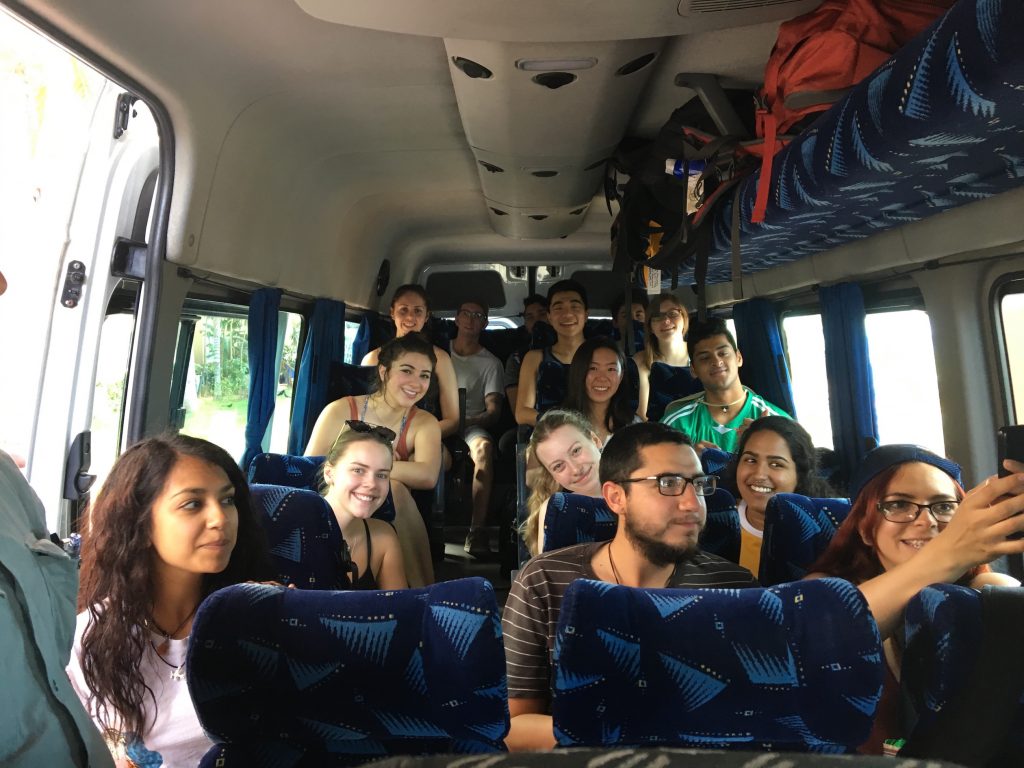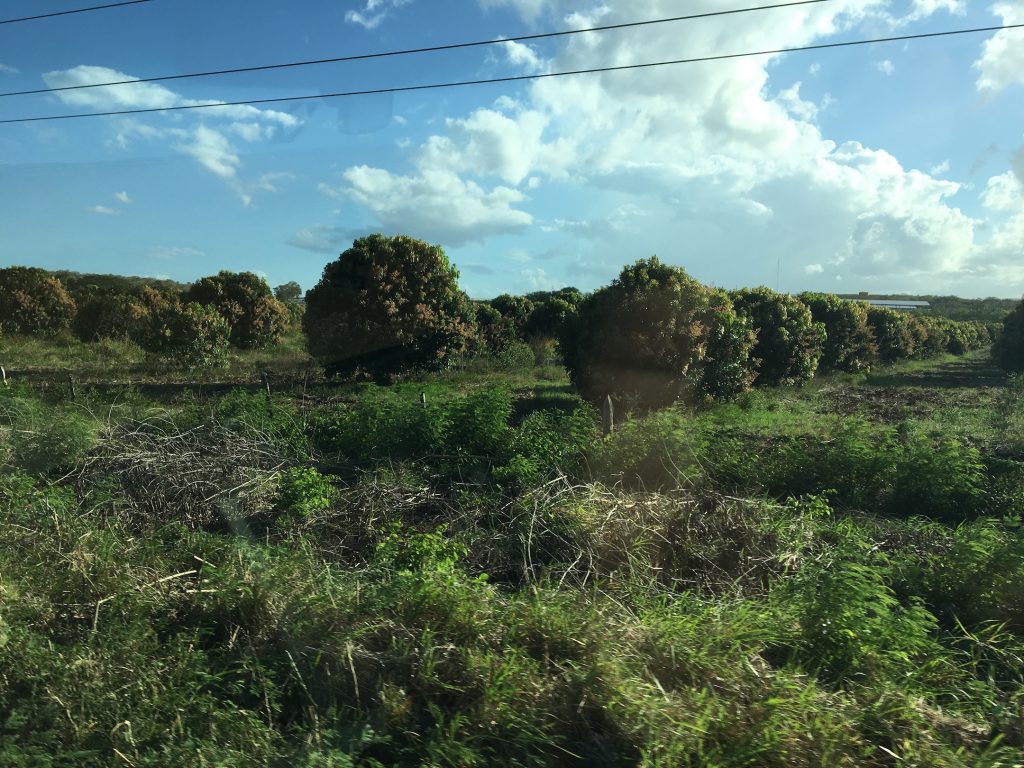Waking up in Campeche 8:30am, students wasted no time and headed directly to the pool. Sleep deprived but extremely excited all the same to be in Mexico. Our first experience with the local cuisine was breakfast of “chilaquiles” (tortillas and salsa picante) at 10am. After packing up and gathering the necessary supplies at the nearby Walmart (i.e. snacks and water), we headed out to explore the city of Campeche. Our guide and Mexican biodiversity expert Javier gave us a detailed tour of the city with a view of the Gulf of Mexico. He was sure to point out important historical features such as the fortress that surrounded the city, equipped with cannons (to thwart the attacks of pirates), followed by a quick tour of the town plaza, the central cathedral, and the gate to the city.
After our tour, we had the opportunity to drive through the local University of Campeche camous, before carrying on 30 minutes to the CEDUSU (Centre for the Study of Sustainable Development). Here we met five different professors, specializing in a variety of different disciplines ranging from plant taxonomy through herpetology to mammalian biology. After being split into two groups, we toured the museum’s collection of specimens and samples, many of which were native to Mexico and more specifically the Yucatan peninsula. We had the opportunity to visit three separate areas in the centre. One was a room housing the vertebrate collection with data regarding their classification. Skins, skulls and bones of birds and mammals, as well as preserved reptiles along with amphibians were available to examine, each with provenance, collector and date. We also visited the public face of the museum with dioramas organized according to habitat from the littoral zone, through mangroves, to forests of various statures. The final room that we visited was the herbarium with plant specimens of species native to the state of Campeche – the number of plant records was astonishing, all organized according to the phylogeny (evolutionary history) of plants. As a final stop, we visited a laboratory where specimens were prepared – they were currently preparing a fawn skin shown in one of the photos. This concluded our tour at the centre and we thank our hosts and guides; this was a great start to our Mexican adventure. We climbed into our vehicle (a small Mercedes bus), with three more Mexican students from the University of Campeche) joining us (Hector, Adriana, Zafiro). Our trip to the small town of Zoh-Laguna was about three hours as we passed through an interesting countryside comprised of small villages, plantations of mango and papaya (with fallow fields of corn and one field of sugar cane) with secondary forests. We arrived after dark at our destination –Zoh-Laguna Hostel. We had a lovely late dinner, and then had a class discussion of science as a framework for understanding the natural and physical world, and the use of hypotheses to advance our understanding of biodiversity and conservation.
Español
Amaneciendo en Campeche a las 8:30am, los estudiantes fueron directo a la alberca del hotel, con poco tiempo de dormir pero con mucha emoción de estar en México. Nuestra primera experiencia con la comida fue un desayuno de chilaquiles a las 10am. Una vez que empacamos, y que pasamos a un Waltmart cercano a comprar botanas y agua, nos fuimos a explorer la ciudad de Campeche. Nuestro guia experto en biodiversidad, Javier, nos dio una explicación detallada de la historia de la ciudad con vista al Golfo de México. Nos describió aspectos históricos importantes como la muralla y fuertes equipados con cañones para proteger la ciudad del ataque de piratas. Después pasamos al frente de la plaza principal, su catedral, y la puerta de mar que era la principal entrada a la ciudad.
Después del tour pasamos por el campus de la Universidad de Campeche antes de llegar al Centro de estudios de desarrollo sustentable (CEDESU). Conocimo cinco profesores especialistas en varias disciplinas, incluyendo un taxónomo de plantas y otros en herpetología y mastozoología. No separaron en dos grupos para visitar las colecciones científicas del museo que albergan muchos ejemplares y muestras de especies nativas de México, pero particularmente de la Península de Yucatán. Visitamos tres áreas diferentes, una donde se alojan las colecciones científicas con datos relaciondos a su clasificación taxonómica. Pieles, cráneos y huesos de de aves y mamíferos, así como ejemplares de reptiles y anfibios disponibles para observación y con datos de su orígen, fecha y colector. También visitamos el area de exhibición con dioramas para el publico organizados de acuerdo a ecosistemas desde la zona litoral hasta las selvas de varias estaturas. El area final que visitamos fue el herbario que aloja un número importante de especies de Campeche donde se ha estimado un número de especies sorprendente. Por ultimo visitamos un área de preparación de ejemplares donde estaban preparando una piel de cervatillo mostrada en fotos. Concluímos nuestra visita al centro, agradecimos a nuestros anfitriones; fue una gran manera de iniciar nuestra aventura en México. Subimos al autobus (un pequeño Mercedes) con tres estudiantes adicionales de Campeche (Héctor, Adriana y Zafiro). Nuestro viaje al poblado de Zoh-laguna fue de tres horas, pasando por sitios y paisajes interesantes, incluyendo pequeños poblados en la zona rural con plantaciones de mango y papaya, campos cosechados de maíz y caña de azucar, además de bosque secundario. Llegamos al obscurecer a nuestro destino en el Hostal-Zoh-Laguna. Nos dieron una rica cena y por ultimo tuvimos una clase introductoria y discusion sobre ciencia y la importancia de las hipótesis para entender de major manera nuestro mundo natural.

